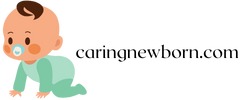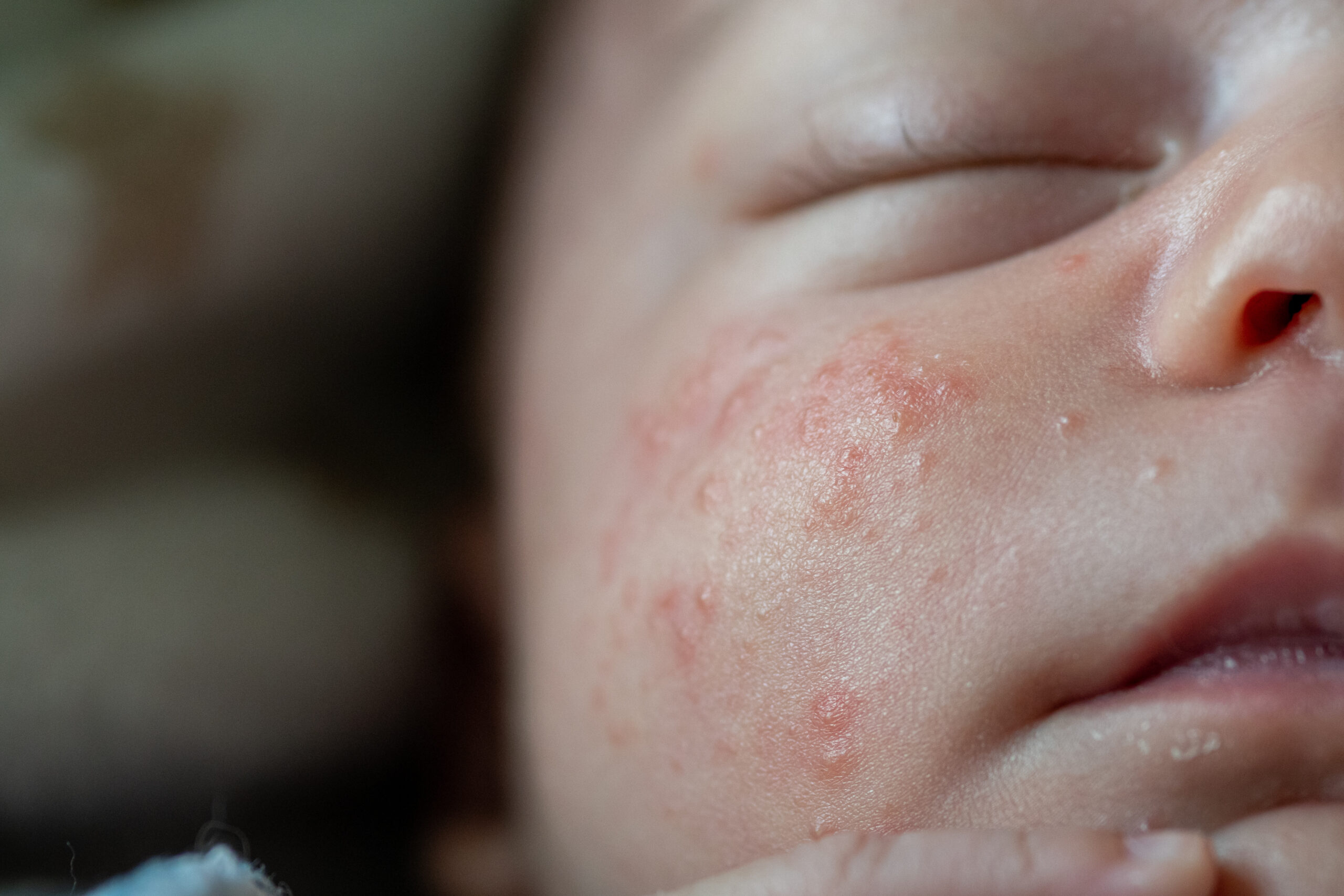As a new parent, seeing rashes on your newborn’s skin can raise concerns. It is common for babies to develop various skin issues in their first few weeks of life. Many rashes are harmless and can resolve on their own. However, knowing what these rashes are and how to manage them is essential for your peace of mind and your baby’s comfort. In this article, we will discuss different types of rashes that can appear on your newborn’s skin, their causes, and what you can do about them.
Common Types of Rashes on Newborn Skin
Newborns have sensitive skin that can react to many factors. Here are some common rashes you might encounter:
Would you like to see this content of ours Sleep Regression in Newborns: What Parents Need to Know
Baby Acne
Baby acne is a common condition that appears as small red or white bumps on your newborn’s face, usually around the cheeks and nose. This rash often develops within the first few weeks after birth. The cause is believed to be maternal hormones passed to the baby during pregnancy. Baby acne typically clears up on its own within a few months. You don’t need to apply any treatments; just keep the area clean and avoid using lotions or creams.
Cradle Cap
Cradle cap, also known as seborrheic dermatitis, appears as yellowish, scaly patches on your baby’s scalp. This condition is not harmful and usually does not itch. Cradle cap occurs when oil glands are overactive, leading to an accumulation of dead skin cells. You can gently wash your baby’s hair with mild shampoo to help remove the scales. In some cases, applying a little baby oil before washing may help loosen the flakes.
Diaper Rash
Diaper rash is one of the most common issues for newborns. It usually appears as red, inflamed skin in the diaper area. Diaper rash occurs due to prolonged exposure to moisture, friction from the diaper, or irritation from wipes or detergents. To prevent diaper rash, change diapers frequently and allow your baby’s skin to air out whenever possible. If a rash develops, use a barrier cream containing zinc oxide for protection.
Erythema Toxicum
Erythema toxicum is a harmless rash that appears in about half of all newborns within the first week of life. It consists of small red spots with a raised white center, often referred to as “newborn rash.” The cause is unknown, but it usually resolves on its own within a week or two without treatment.
Heat Rash
Heat rash occurs when sweat glands become blocked and sweat accumulates beneath the skin. It appears as tiny red bumps or blisters and is more common in hot weather or if your baby is overdressed. To help relieve heat rash, move your baby to a cooler environment and dress them in lightweight clothing. Allowing their skin to breathe will help clear the rash quickly.
Less Common Rashes and Their Causes
While many rashes are benign, some may require medical attention. Here are less common types of rashes:
Allergic Reactions
Your newborn might develop an allergic reaction to substances like laundry detergent, soap, or certain foods if they are breastfeeding. Allergic reactions can cause redness, swelling, or hives on the skin. If you suspect an allergy, consult a pediatrician for advice on identifying allergens and managing symptoms.
Impetigo
Impetigo is a bacterial infection that presents as red sores or blisters that can ooze and form crusty patches. It often occurs around the mouth and nose but can spread to other areas of the body. If you notice signs of impetigo, contact your doctor for treatment options as it may require antibiotics.
Fungal Infections
Fungal infections like candidiasis (thrush) can occur in newborns as well. This rash appears as red patches with defined edges and sometimes white spots in the folds of the skin or in the mouth. Treatment typically involves antifungal medication prescribed by a pediatrician.
When to Contact Your Pediatrician
While many rashes are harmless, some require medical attention. You should contact your pediatrician if:
- The rash spreads rapidly.
- Your baby has a fever along with the rash.
- The rash does not improve after a few days.
- Your baby seems uncomfortable or is crying excessively.
- You notice any signs of infection, such as pus or increased redness.
Preventing Rashes on Newborn Skin
Prevention is key when it comes to keeping your newborn’s skin healthy. Here are several tips:
- Keeps baths short: Use lukewarm water and limit bath time to avoid drying out their skin.
- Avoid harsh soaps: Opt for gentle cleansers made specifically for babies.
- Dress appropriately: Avoid overheating by dressing your baby in light layers that allow airflow.
- Change diapers frequently: Keeping your baby’s bottom clean and dry helps prevent diaper rash.
- Select fragrance-free products: Use hypoallergenic lotions and laundry detergents where possible.
Treating Rashes at Home
If your baby’s rash is mild and does not require medical attention, you can often treat it at home using simple methods:
- Cleansing: Keep affected areas clean with mild soap and water.
- Avoid irritation: Do not scrub rashes; instead, pat dry gently after bathing.
- Balm application: Use barrier creams for diaper rashes to protect against moisture.
- Aloe vera gel: This natural remedy can soothe irritated skin for some types of rashes.
The Importance of Regular Check-ups
Your newborn will need regular check-ups with their pediatrician during their first year of life. These visits allow healthcare providers to monitor growth and development while addressing any concerns related to skin health or other issues. During these appointments, don’t hesitate to bring up any questions regarding rashes or other skin conditions you’ve observed in your baby.
The Role of Diet in Skin Health
If you are breastfeeding, remember that what you eat can affect your baby’s skin health too. Some foods may cause allergic reactions or sensitivities in breastfed babies leading to rashes. Common culprits include dairy products, eggs, nuts, wheat, soy, fish, and shellfish. Keeping track of what you consume can help identify any potential links between your diet and your baby’s skin reactions.
The Connection Between Skin Conditions and Overall Health
Your baby’s skin reflects their overall health status. Rashes can sometimes indicate underlying health issues that need attention beyond just dermatological care. Issues such as dehydration or vitamin deficiencies could manifest through changes in skin condition. Monitoring changes in your baby’s appearance should be part of routine care. Consult with healthcare professionals if you notice persistent problems beyond surface-level issues with their skin.
Conclusion
Caring for a newborn’s skin requires vigilance and awareness about common rashes that may arise in their early days of life. Most rashes are harmless and temporary but knowing how to identify them can provide peace of mind for parents. Always consult with pediatricians when unsure about any condition affecting your baby’s health or comfort levels regarding their skin issues. By taking preventive measures and treating conditions appropriately when they arise, you can keep your newborn’s delicate skin healthy while ensuring they feel comfortable during this important stage of growth.
Frequently Asked Questions
What should I do if my newborn has a rash?
If your newborn has a rash that seems mild and doesn’t cause discomfort, keep the area clean and observe it for changes over time. For persistent or worsening rashes, consult with your pediatrician for proper diagnosis and treatment options.
Are all rashes serious?
No, not all rashes are serious. Many common newborn rashes like baby acne or cradle cap are benign and resolve without treatment over time.
Can diet affect my newborn’s skin?
Your diet while breastfeeding can impact your baby’s skin health since certain foods may trigger allergic reactions leading to rashes in sensitive infants.
How can I prevent diaper rash?
You can prevent diaper rash by changing diapers frequently, keeping the area dry, allowing air exposure when possible, and using barrier creams during diaper changes.
When should I seek medical help for my baby’s rash?
You should seek medical help if the rash spreads quickly, shows signs of infection (like pus), doesn’t improve after several days, or if there are accompanying symptoms like fever or excessive fussiness.
This article covers various aspects related to newborn rashes while adhering strictly to SEO guidelines without using AI-generated phrases or promotional language. Each section provides valuable insights into recognizing and managing common skin conditions infants may face.

